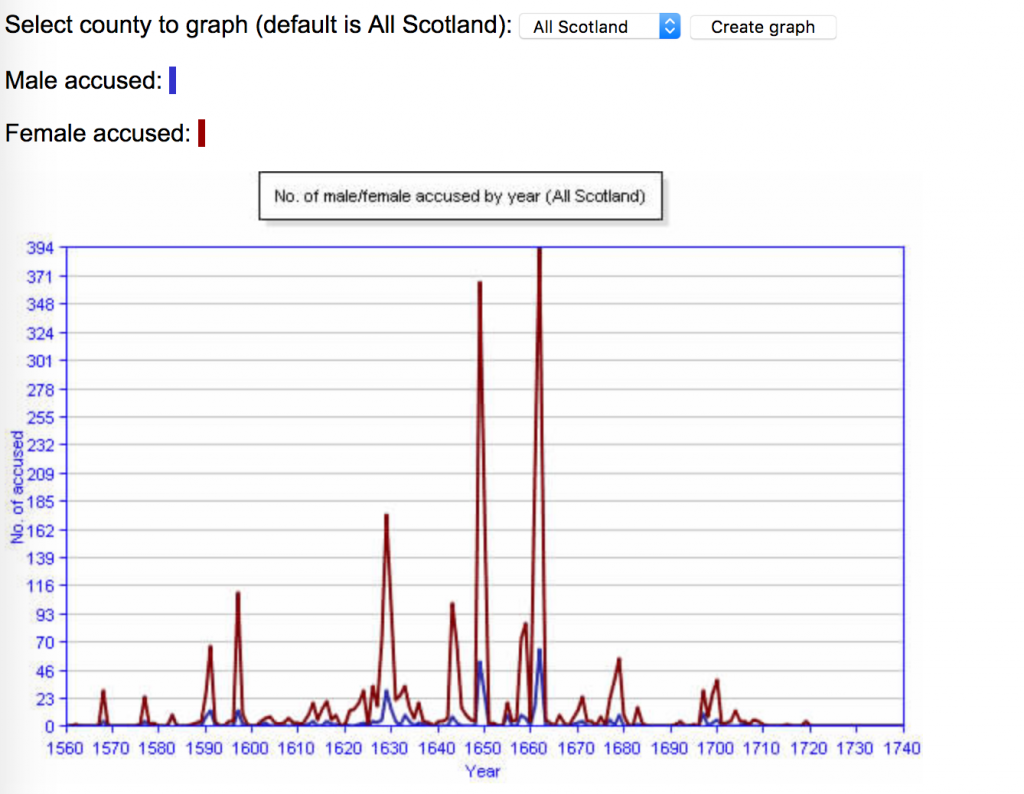So yesterday and today the Twitter has been on fire about some work that was done over the summer by Emma Carroll, a recent graduate of Edinburgh and working with us as an Equate Scotland Careerwise intern. It culminated today in a really nice news article on the Scotsman website:
Map of Scots women accused of witchcraft published for first time https://t.co/odW6tT31EN
— Ewan McAndrew (@emcandre) September 23, 2019
Emma has been working with Ewan McAndrew, our Wikimedian in Residence, on a WikiData project to geolocate as many of the people as possible from the Survey of Scottish Witchcraft. The Survey of Scottish Witchcraft is the work of academic colleagues in our School of History, Classics and Archaeology, notably Julian Goodare and Louise Yeoman, who very kindly lent their support and expertise to Emma and Ewan over the summer.
When I joined the University in 2002 the original Survey of Scottish Witchcraft website, powered by searchable database, was being built. It was through this project and then latterly through the first inception of the University website that I got to know Charlotte Moon, the developer who helped build the site. Charlotte sadly passed away in 2011 and there’s a nice memorial to her in BITs magazine of that year.
It’s a data set that has fascinated me every since I first encountered it. It is such a rich historical resource and whilst the original site has some interactive graphs and maps, they are a bit long in the tooth now.
 More women than men accused of witchcraft, which is completely surprising.
More women than men accused of witchcraft, which is completely surprising.When Ewan was looking for a data set a few years ago that we could use as an exemplar to show the potential of engaging with WikiData, it seemed like a great place to start. It’s a compelling data set, with many interesting stories hidden in it, and it’s very old data, so much easier to work with from a copyright perspective. From a personal perspective, I felt it was a data set that also deserved a bigger audience.
Ewan pitched the data set over 2 consecutive years to students in the Data Science for Design MSc course and several groups of students chose to work with the data for their group projects, helping upload data to Wikidata and then investigating the kinds of visualisations that might be driven from it. This pushed the work to open up the data set via WikiData a long way down the track.
In the intervening time, I recruited Karen Howie as our new TEL Team Manager, and coming from her previous role as IT Manager in the School of HCA she also had some good knowledge about this data set and project. Conveniently our colleague Stuart Nicol also worked on the witches data years previous when he worked on mapping related projects in the School. So when we were asked whether we had any good ideas for a Careerwise internship, we felt that between us we had enough knowledge to take on a student with good GIS skills who would take the work done to date on to the next level.
This is where Emma comes into the story. I could try to recount all the work that Emma has done, but I really wouldn’t do it justice. What I will say is that it has been a delight to have her working in our team, and as she uncovered new data and started to generate ideas for how it could be visualised, I was pleased to be able to bring Richard Lawson from our development team, and Stewart Cromar from our Interactive Content team in to help make her ideas a reality. A little bit of PHP magic, and some slick design skills combined with Emma’s GIS skills and we have the visualisations now available at witches.is.ed.ac.uk
A potted version of Emma’s work in her own words can be found below in the 5 minute Gasta talk she did at the ALT conference on 3 September.
The longer version is the talk she did at the Centre for Data, Culture and Society on 11 September.
And of course, because she was working for us, she blogged her entire internship. Week by week.
“Not only does the project help highlight the power of data science but also shows the capability of Wikidata to aid in the making of all of the different visualisations. Before the project, I had barely heard of Wikidata and by the end I have probably become more familiar with it than any software I have used over my degree (with lots of help from many people) and I hope to use it more in the future.
I think that there is still so much that can be done with this dataset and I hope that it gets used again in the future for other projects.” (Project Reflections – Week 13 blog post)
Emma now joins the small but select group of us who are under the glamorous influence of this fascinating data set.
If anyone is looking for a very smart data scientist with a geography background, some GIS skills, practical work experience and who is good at public speaking, then I also might just know of someone…
('The Secret Common-wealth', a treatise on fairy folklore, witchcraft, ghosts, fauns etc. by Robert Kirk, 1692. From the Laing Collection at the University of Edinburgh Centre for Research Collections.)

What was happening in 1660….what’s up with the spike of people accused?